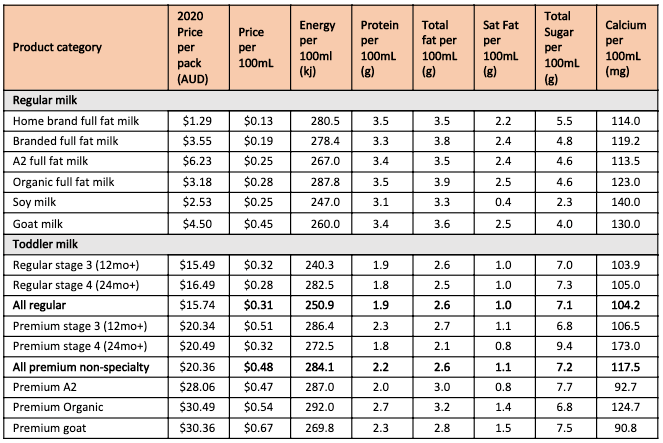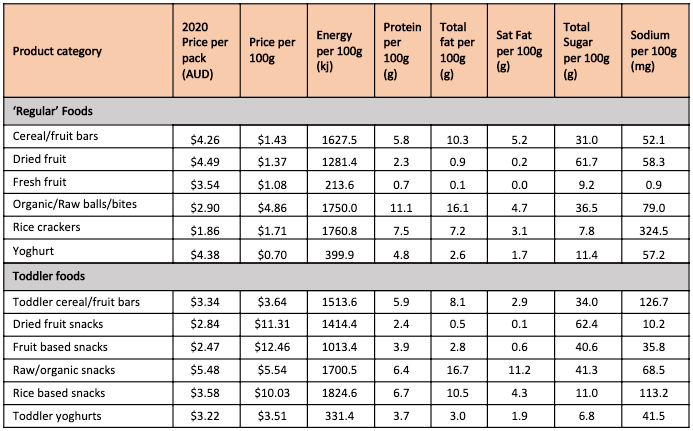The Deakin University and VicHealth study of 50 milks targeted at children aged 12 months and over found some cost up to $1.02 per 200mL serve1, while regular cow's milk costs just 26 cents a serve – if drank daily, toddler milk would cost a family as much as $23.56 more per month than regular milk.
VicHealth CEO Dr Sandro Demaio said toddler milks are incredibly expensive and completely unnecessary.
"This research shows that toddler milk formulas are up to four times more expensive than their regular fresh milk counterparts. They're also less nutritious, containing more sugar and less protein than regular milk, while many also offer less calcium," Dr Demaio said.
"Despite this, manufacturers are using Instagram influencers, targeted digital advertising and on-pack claims to try and lure Australian families into believing these ridiculously priced products are 'essential' for their child's health.
"At a time when many families are finding it hard to afford healthy food, the last thing they need is to be guilted into thinking they should fork out excessive amounts of money on these unnecessary products."
Almost 1 in 6 Victorians were worried about being able to afford to put food on the table during the first coronavirus lockdown, a recent VicHealth survey found. More than a quarter of single-parent families and 1 in 10 families on low incomes ran out of food and couldn't afford to buy more2.
Some toddler milks contained up to 8g more sugar per 200mL serve than an equivalent fresh milk product. If drank daily, a child would consume around 240g more sugar – or 60 teaspoons – over a month vs. the fresh milk option.
Dr Demaio said toddler milks fall into a regulatory loophole when it comes to marketing, and they may be harmful to a child's health long-term.
"Unlike infant milk formulas, marketing claims about toddler milk products are under-regulated in Australia," Dr Demaio said.
"This is potentially dangerous, as toddler milks could be harmful to the health of growing children. If children consume these toddler products instead of exploring regular foods and drinks, they won't have a chance to develop healthy eating habits that are vital for a long, healthy and happy life.
"The Federal Government must urgently act to set higher standards for more honest labelling of added sugars and how these toddler products are marketed to families."
Researchers also looked at 88 toddler yoghurts and snacks, and found that, on average:
- toddler yoghurts cost around $2.20 more per serve than regular yoghurt. A family would need to fork out $68 more to feed a child toddler-branded yoghurt each day for a month.
- fruit-based toddler snacks3 were almost 12 times more expensive than fresh fruit, costing on average $124.60 per kg vs. $10.80 for 1kg of fresh fruit.
- toddler dried fruit was more than 8 times the price of regular dried fruit ($113.10 per kg vs $13.70 per kg).
- toddler fruit snacks contained much more sugar per 100g than fresh fruit – 40g vs 9.2g respectively.
Deakin University PhD student Jennifer McCann said like toddler milks, foods marketed specifically for toddlers do not provide value for money and are often packed with harmful added sugars.
"It's much more cost effective and often healthier to buy regular whole foods and portion them into toddler-sized servings at home," Ms McCann said.
"When a child reaches 12 months, they can eat and drink regular whole foods, yoghurt, fresh fruit or vegetables. Regular, healthy family foods are better for a toddler's health while also being much more affordable for families."
Parents' Voice manager Alice Pryor said it's worrying to see a rise in manufacturers using Instagram influencers to sneakily promote toddler milks and foods to Australian families.
"Toddler milk and food companies are increasingly using Instagram influencers to promote their products to their very large followings of loyal women and mums," Ms Pryor said.
"Mum influencers have become extremely clever at making casual recommendations for toddler foods and milks in their own 'voice' via their Instagram accounts, to make their posts look less like an advertisement.
"But influencers often don't disclose these posts as paid partnerships, so families are likely unaware the influencer is being paid or compensated for their so-called opinion, which is very concerning."
About the research:
The findings for this study, which were based on data primarily collected as part of a Deakin PhD project, examined the cost and nutritional profiles of 138 products marketed as specifically for toddlers, including 50 toddler milk formulas and 88 foods such as yoghurts and fruit snacks. This was then compared to similar non-toddler food and milks, such as fresh full fat, organic, and A2 varieties of milk, fruit, vegetables, plain yoghurt, crackers and muesli bars. The data was collected from the products in store and from online Coles and Woolworths stores in November 2019 and September 2020.
What's the difference between different infant and toddler milks?
Infants under 12 months who are unable to be breastfed need specially developed infant formulas, which are fortified and nutritionally adequate (plain cow's milk is not appropriate). But after 12 months of age, plain cow's milk is appropriate along with regular family foods and breastfeeding. Formulas are no longer needed after 12 months.
- Infant formula (stage 1) (0 – 6 months)4
- Infant formula (stage 2) (6-12 months) similar in nutrient profile to stage 15
- Follow-on formula/toddler milks (Stage 3) – marketed for 12 months+6
1 Calculations based on 200mL, which is a typical serving size for a toddler and the average serving size shown on the nutrition information panel of toddler milks.
2Findings from the VicHealth Coronavirus Victorian Wellbeing Impact Study, a survey of 2,000 Victorians conducted during the first coronavirus lockdown of 2020. Data based on families with 2 parents, children under 18 and combined household income of $40,000+ a year.
3Fruit based snacks included only snacks which were primarily fruit, such as purees, fruit chews and fruit buttons.
4https://raisingchildren.net.au/newborns/breastfeeding-bottle-feeding/bottle-feeding/infant-formula
5https://raisingchildren.net.au/newborns/breastfeeding-bottle-feeding/bottle-feeding/infant-formula
6https://www.phaa.net.au/documents/item/1280
Table 1: Cost and nutritional data for fresh full fat milk and toddler milk categories

Table 2: Cost and nutritional data for 'regular' foods and toddler food categories







